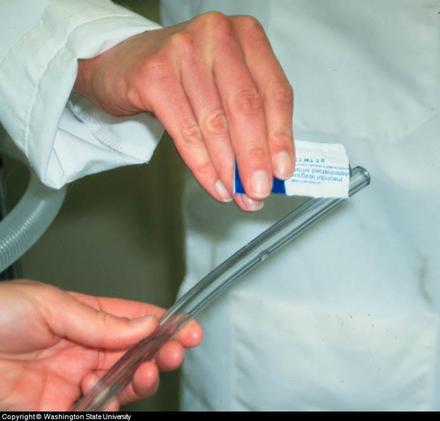The story of Northstar,a horse that was severely burned whcn doused with a flammable liquid and set on fire last summer is having a somewhat happy ending. Northstar is alive and well after two doctors, one a veterinarian and the other a human medical doctor teamed to give the badly burned horse a second chance.

Medical care giving severely burned horse a chance
The story of Northstar, a horse that was severely burned whcn doused with a flammable liquid and set on fire last summer approaches a happy ending.
The Ohio State University doctors and their teams partnered to perform two skin graft procedures on the American Paint Horse named Northstar, who suffered severe burns to almost half of his body when set on fire.
The same instruments used in a typical human burn surgery were used for the horse's grafting procedures. The clinicians removed ultrathin sheets of skin from Northstar's chest and expanded them with a meshing tool before placing the grafts across an enormous wound spanning the horse's back.
When he arrived in Columbus on Sept. 5, Northstar had exposed bone at the base of his neck as a result of the burns. Skin damage extended from his neck to the base of his tail and along both of his sides. No suspect has been identified in the case.
According to a Samuel Hurcome, assistant professor of veterinary clinical sciences and leader of the care team for Northstar, "There's been a lot of trial and error with the challenges of how to bandage him, what the most appropriate antiseptic is for cleaning the wound bed, and the biology of burned tissue in a horse.
Veterinary experts got the healing off to a good start with relentless wound management, a series of smaller skin grafts and the implantation of cell cultures in the wound bed. These procedures were performed to bring top-layer skin tissue to the central area of the expansive wound bed on Northstar's neck and shoulders, where all his skin had burned away.
To address the large wound across the horse's back, Hurcombe consulted longtime trauma and burn surgeon Larry Jones at Ohio State's Wexner Medical Center. The two observed one another's surgeries and studied human- and veterinary-medicine journal articles before teaming to accelerate Northstar's care.
Jones, associate professor of clinical surgery and director of the Burn Center at the medical center, led the two larger skin graft surgeries. Early on, he encountered a significant challenge: how deep to set the tool that would peel off the donor skin.
"We want to take the top layer of skin but we also need a portion of the second layer, the dermis," he said. After Jones consulted with Hurcombe and the two conducted more research, "I knew I had to take a graft that's about twice as thick as one I would take if I were operating on a human."
They dressed the wounds with bandages containing medical-grade silver, which functions as an antibiotic, to speed healing of the grafts and the donor sites.
At this stage of the horse's recovery, more than half of the initial wound was healed, with the repair resulting from both the various skin grafting procedures and normal closure along the edges of the damaged skin. Northstar will likely undergo a series of additional sheet graft surgeries to completely heal the wound. Multiple grafts are often required for extensive human burn injuries, as well.
According to the doctors working with Northstar, his psychology ia positive and he continues to trust the people who working with him which is "pretty amazing."
While he initially appeared to be a dark horse for recovery, Northstar persevered through weeks of daily cleansing and removal of dead and infected tissue followed by the application of antiseptics, honey, aloe and silver sulfadiazine cream, a common human burn treatment, to his damaged tissue.
In yet another application of human medicine in veterinary care, the team has treated Northstar with gabapentin (sold under the brand name Neurontin), a medication used for neuropathic pain in humans, to treat the severe itching and nerve-related pain that is typical in burn patients as they recover.
Northstar, who turned 7 in January, is a "young, naughty boy" and would love nothing more than to toss himself to the ground and roll on his back to scratch that persistent itch, Hurcombe said. So the horse is gently tethered to keep him standing and he wears a cradle that immobilizes his neck several hours throughout the day. He is also covered in bandages and wears what is called a full-body "sleazy" covering that is typically seen on show horses.
The clinicians hope that Northstar will have a complete layer of skin coverage by his 8th birthday. The road ahead is a long one, both physicians acknowledge. The location of his back wound is a tricky one to treat because even with secure bandages from his neck to his tail, the horse anatomy in the location of the burn is such that Northstar's every movement slightly disturbs the grafted areas.
Northstar's owners live in northwestern Pennsylvania, where police have investigated the burning incident as a criminal case.
